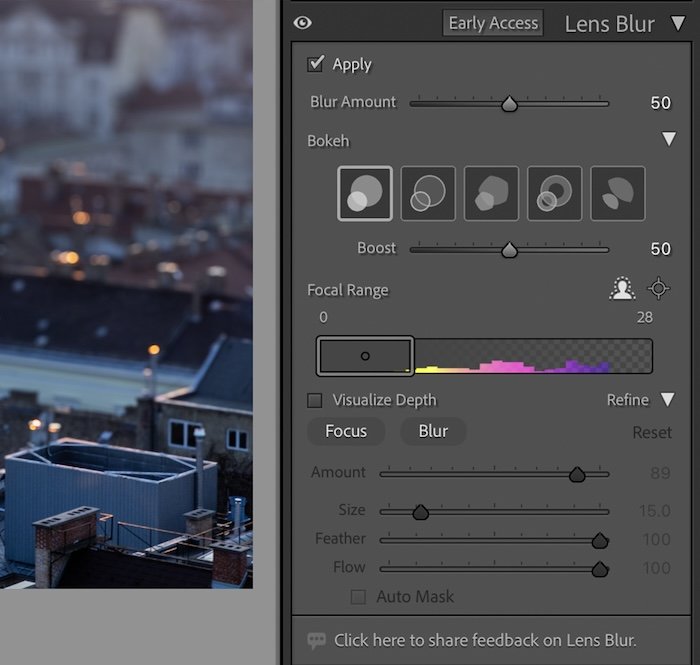This article will teach you how to blur the background in Adobe Lightroom. It’s a useful process to know and can really improve your photos.
A typical rookie photographer’s mistake is to focus so much on your subject that you lose track of what is around it. And sometimes, you take photos where the background distracts from your subject.
So we’ll take you through each editing stage in Lightroom Classic to add blur for cases like this. (We’ll show you three ways, depending on your version of Lightroom). Adding background blur will help make your subjects stand out better.
When to Blur the Background in Lightroom
Of course, it’s always easier if you don’t need to make this adjustment in post-processing at all. Getting it right at the time of shooting will save you the work.
The sooner you learn to pay attention to a subject’s surroundings while shooting, the better. There are two details to look for in general.
If the subject is in the background, the foreground might contain an element of interest. But it shouldn’t distract from your subject.
And the second detail to look out for is… If the subject is in the foreground, the background shouldn’t be so distracting that it diverts the viewer’s eyes.
Sometimes it is possible to fix things in post-production. You can add interesting elements in the foreground, thus creating a composite image. Or you can blur the background. So it’s less distracting and makes your subject stand out more.
Read on to learn how to blur a distracting background in Lightroom. And if you want to know more about how to get it right straight out of the camera, check out the bonus section at the end.

Blur the Background in Lightroom CC vs. Lightroom Classic
Do you want to blur the background in Lightroom but are unsure which Lightroom version is best? Don’t worry; both versions allow you to perform the same actions with the same detail. There are usually small differences between the Lightroom versions, but they are very similar when considering the techniques we are talking about.
The only point you must be aware of is that finding the Masking section differs in Lightroom Classic vs. CC. You can find the same icon in Lightroom CC along the right-hand toolbar.
Different Techniques to Blur the Background in Lightroom
In this article, we will cover three different methods to blur your background in Lightroom. Theres are:
Click these links above to go the section that may be the most relevant for you!
Blur the Background in Lightroom Using Lens Blur
One of the newest features in Lightroom is the Lens Blur tool. This has massively decreased the time it takes to blur the background in Lightroom. The Lens Blur tool uses AI to identify key features and apply different styles of bokeh to your photograph.
One of my favorite features is that it allows you to visualize and edit the focal range. This allows you to have great control over what areas are blurred. It even has a brush to blur sections that may be in the foreground, but you want to be blurred!
Step 1. Open the Image and Find Lens Blur
First, find your image, go to the Lens Blur panel, and click Apply.

Step 2. Choose the Blur
You will then want to set your blur amount and the bokeh style you want. This is the only way to choose the kind of blur effect you get when you blur the background in Lightroom. There are five options to choose from that reflect different aperture styles, which in turn dictate the blur style.

Step 3. Set the Blur Distance
You are now able to fine-tune the blur distance. The Focal range slider is a unique slider that uses AI to judge the distance of objects in your image. This slider works surprisingly well.
My favorite bit is that you can click the ‘Visualize Depth’ button to see how the AI reads your image.

Step 4. Fine Tune Your Selection
You can now click on the Blur button to fine-tune your blurred areas. This will bring up a Brush tool with its own Blur Amount and other brush customizations.
This is helpful to get areas that may exist in a similar focal range to your main subject but you want them blurred.
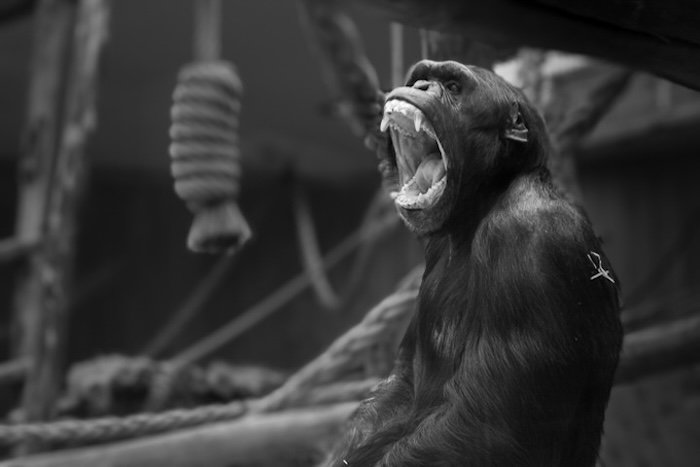
Blur the Background in Lightroom Using an AI Mask
If you have updated Lightroom Classic (after October 2022), you will have access to all of the new AI features! Here is a super-quick and simple walkthrough of blurring the background with these new tools.
We will show you three masking options to highlight the background. The first option is masking the subject and inverting the selection. This takes a bit longer. And it may need work with the Brush tool.
The second option is even quicker by using the AI background mask. And finally, if you have an older version of Lightroom Classic, we’ll show you the required brushwork and selections.
Step 1. Open the Image and Select the Masking Icon
First, open your image in Lightroom and go to the Develop page.

You will find a range of icons under the main histogram to the right. Click the Masking icon to begin or press Shift + W.

Step 2. Add a Subject Mask (Option 1)
You will then get a range of options to apply a mask to your image. For our example, we want to blur everything but the monkey. So we’ll click “Select Subject.”

This will apply an AI mask to our image. As the image I have used is black and white, it can be hard to identify the parts in the foreground and background. Surprisingly, the AI has even noticed our rope is more in the foreground than other objects!
This is great, but I also want the rope to be blurred for this image. Here’s how to remove certain sections from your mask.

We will click the “Subtract” box in our current selection. And for this method, I will show you how to use the Brush tool, as it is the easiest and quickest method.

After selecting the Brush tool, brush over the parts you want to be blurred. Your image should end up looking like this.

You can invert your selection when your subject is fully masked. Do this by right-clicking on Mask 1 and clicking “Invert.”

Your image should now look like this.

Step 2. Add a Background Mask (Option 2)
Those with the most up-to-date Lightroom Classic get a third option to mask the background. So click “Background.” The AI should automatically select the subject.
You will get the same result as the masked photo above—just quicker! And you can make the same brush adjustments as necessary.

Step 3. Apply Blur By Reducing the Sharpness Slider
Now we’re ready to apply blur to your background. You will see a range of adjustments you can apply to your mask in the Adjustments panel.

Look for the Sharpness adjustment. You can also play with the Texture and Clarity adjustments for a more subtle effect. To make the difference clear, I will move the Sharpness slider quite far to make the subject pop.

Here is the final result (before and after). And it took me under two minutes to create!
If you don’t have the most up-to-date version of Lightroom, follow the instructions below!
Blurring the Background Using Lightroom Brush Tool
This is the third option for older versions of Lightroom without AI features.
The Brush tool is used to apply an effect to a part of your image.
- The mask part of the Brush panel lets you create a new mask or edit an existing one.
- In the Effect section of the panel, you can choose a preset or manually create your effect.
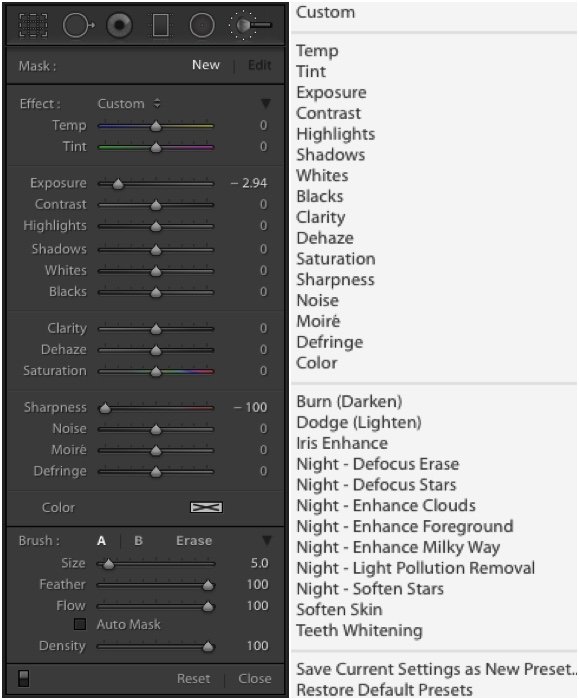
- The Brush section of the panel lets you define effects for two brushes.
- The brush properties can be changed anytime and will not affect the painted parts.
These are the brush settings you can apply:
- Size: Sets the relative size.
- Feather: Sets how soft or hard the brush is.
- Flow: Sets the strength of the brush. Use a value lower than 100 to slowly build the effect while painting in the same area.
- Auto Mask: Toggle on to help you follow borders when you paint.
- Density: Sets a cap for the maximum strength of the brush.
Step 1. Open the Image and Select the Brush Tool
Open your image in the Develop Module of Lightroom. Select the Sharpening Adjustment Brush tool.
Step 2. Adjust the Sharpening Slider and Paint the Background
Then set the sharpening slider to -100 and start painting over the background. You do not need to be precise at this stage.
Use the keyboard shortcut “O” to show or hide the selected mask overlay (displayed in red). This way, it will be easier to see where you’re painting. While the mask overlay is on, the brush effect on the image is not shown.

Once you have a coarse mask, start working around the edges. Tune the Size, Flow, Density, and Feather of your brush to refine the mask edges. Sometimes, the Auto Mask option can help you with this.
Eventually, you might have to use the Erase brush to clean up your subject. That ensures that the blur effect is applied only to the background.
Remember that the amount of blur gradually increases with the distance from the focal plane for a realistic blur. All the objects on the focal plane must be kept sharp.
After the paint-and-erase process, you’ll have a good mask.
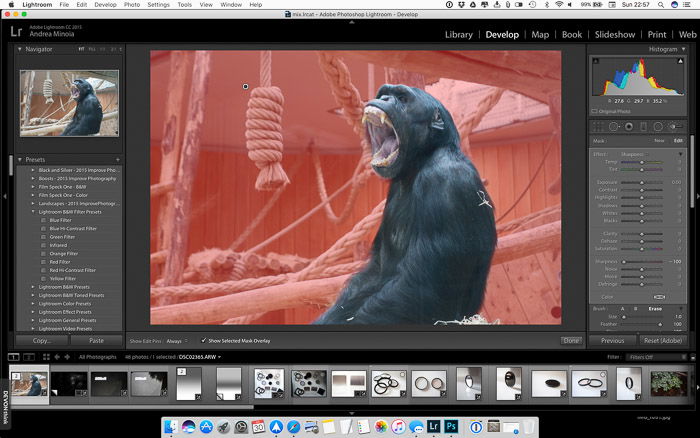

Step 3. Increase the Amount of Blur
Setting the Sharpness to -100 introduced a certain amount of lens blur, but not much. The good thing about Lightroom is that you can duplicate your Adjustment brush by simply right-clicking on the brush marker and selecting “Duplicate.”

This new brush has the same settings and mask as the previous one. Be sure all the sliders are set to 0 except Sharpness, which should be set to -100.
From now on, duplicate the brush as much as you need to apply the blur and create the effect you’re after. But be aware that having many adjustment brushes in an image will slow down Adobe Lightroom.
Step 4. Final Retouches
After blurring the background, you can duplicate the brush one last time. This time, slightly reduce the clarity (set the Sharpness back to 0) to accentuate the blur.
Next, you can use the global settings or other Selective Adjustment tools to make the final adjustments to your image.
When you’re happy with your image, the only thing left to do is export the photo and share the results of your hard work.
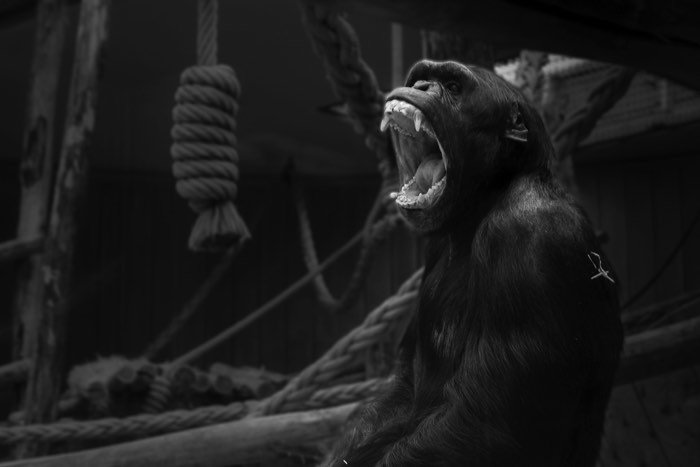
Bonus Section: How to Get Blur Right In-Camera
Your camera sensor size will affect the depth of field. With any given combination of focal length, aperture, and subject distance, small sensors give a greater depth of field than larger sensors.
Depth of field can be modified by the following:
- Aperture: Double the f-number (e.g., move from f/4 to f/8), and the depth of field is also doubled.
- Subject Distance: Double it, and the depth of field increases by a factor of four.
- Focal Length: If you double it, the depth of field is reduced by a factor of four.

Do you want to maximize the depth of field so that most of your landscape is sharp? Then you should use high f-numbers, a short focal length, and focus reasonably far away. A general rule of thumb says you should focus a third of the distance into the scene.
Or do you want to minimize the depth of field to better isolate your subject from the background and have nice bokeh? Then you should use small f-numbers and long focal lengths and move closer to your subject.
And there’s an option if you shoot portraits with natural light outdoors. Using a two- or three-stop neutral density filter allows you to shoot wide open with fast lenses.
Finally, what if you cannot reduce your depth of field further but still need to blur the background? Your last option is to increase the subject-to-background distance, if possible.
Conclusion
We hope we’ve helped you create a beautifully blurred background using Lightroom. Check out our updated Effortless Editing in Lightroom course for even more Adobe Lightroom knowledge!
But don’t forget that you can minimize your depth of field by using the widest aperture. This way, you can get an even separation between your subject and the background without editing!

